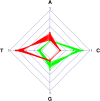The Impact of Selection at the Amino Acid Level on the Usage of Synonymous Codons
- PMID: 28122952
- PMCID: PMC5345726
- DOI: 10.1534/g3.116.038125
The Impact of Selection at the Amino Acid Level on the Usage of Synonymous Codons
Abstract
There are two main forces that affect usage of synonymous codons: directional mutational pressure and selection. The effectiveness of protein translation is usually considered as the main selectional factor. However, biased codon usage can also be a byproduct of a general selection at the amino acid level interacting with nucleotide replacements. To evaluate the validity and strength of such an effect, we superimposed >3.5 billion unrestricted mutational processes on the selection of nonsynonymous substitutions based on the differences in physicochemical properties of the coded amino acids. Using a modified evolutionary optimization algorithm, we determined the conditions in which the effect on the relative codon usage is maximized. We found that the effect is enhanced by mutational processes generating more adenine and thymine than guanine and cytosine, as well as more purines than pyrimidines. Interestingly, this effect is observed only under an unrestricted model of nucleotide substitution, and disappears when the mutational process is time-reversible. Comparison of the simulation results with data for real protein coding sequences indicates that the impact of selection at the amino acid level on synonymous codon usage cannot be neglected. Furthermore, it can considerably interfere, especially in AT-rich genomes, with other selections on codon usage, e.g., translational efficiency. It may also lead to difficulties in the recognition of other effects influencing codon bias, and an overestimation of protein coding sequences whose codon usage is subjected to adaptational selection.
Keywords: amino acid; codon usage; mutation; selection; synonymous codons.
Copyright © 2017 Błażej et al.
Figures








Similar articles
-
The Influence of the Selection at the Amino Acid Level on Synonymous Codon Usage from the Viewpoint of Alternative Genetic Codes.Int J Mol Sci. 2023 Jan 7;24(2):1185. doi: 10.3390/ijms24021185. Int J Mol Sci. 2023. PMID: 36674703 Free PMC article.
-
SENCA: A Multilayered Codon Model to Study the Origins and Dynamics of Codon Usage.Genome Biol Evol. 2016 Aug 25;8(8):2427-41. doi: 10.1093/gbe/evw165. Genome Biol Evol. 2016. PMID: 27401173 Free PMC article.
-
Selection on codon usage for error minimization at the protein level.J Mol Evol. 2004 Sep;59(3):400-15. doi: 10.1007/s00239-004-2634-7. J Mol Evol. 2004. PMID: 15553093
-
The Yin and Yang of codon usage.Hum Mol Genet. 2016 Oct 1;25(R2):R77-R85. doi: 10.1093/hmg/ddw207. Epub 2016 Jun 27. Hum Mol Genet. 2016. PMID: 27354349 Free PMC article. Review.
-
New insights into the factors affecting synonymous codon usage in human infecting Plasmodium species.Acta Trop. 2017 Dec;176:29-33. doi: 10.1016/j.actatropica.2017.07.025. Epub 2017 Jul 24. Acta Trop. 2017. PMID: 28751162 Review.
Cited by
-
No evidence for widespread positive selection on double substitutions within codons in primates and yeasts.Front Genet. 2022 Sep 9;13:991249. doi: 10.3389/fgene.2022.991249. eCollection 2022. Front Genet. 2022. PMID: 36159983 Free PMC article.
-
The Influence of the Selection at the Amino Acid Level on Synonymous Codon Usage from the Viewpoint of Alternative Genetic Codes.Int J Mol Sci. 2023 Jan 7;24(2):1185. doi: 10.3390/ijms24021185. Int J Mol Sci. 2023. PMID: 36674703 Free PMC article.
-
Presyncodon, a Web Server for Gene Design with the Evolutionary Information of the Expression Hosts.Int J Mol Sci. 2018 Dec 4;19(12):3872. doi: 10.3390/ijms19123872. Int J Mol Sci. 2018. PMID: 30518113 Free PMC article.
-
Genetic Code Optimization for Cotranslational Protein Folding: Codon Directional Asymmetry Correlates with Antiparallel Betasheets, tRNA Synthetase Classes.Comput Struct Biotechnol J. 2017 Aug 12;15:412-424. doi: 10.1016/j.csbj.2017.08.001. eCollection 2017. Comput Struct Biotechnol J. 2017. PMID: 28924459 Free PMC article.
-
Amino acid sequence encodes protein abundance shaped by protein stability at reduced synthesis cost.Protein Sci. 2025 Jan;34(1):e5239. doi: 10.1002/pro.5239. Protein Sci. 2025. PMID: 39665261 Free PMC article.
References
-
- Banerjee T., Basak S., Gupta S. K., Ghosh T. C., 2004. Evolutionary forces in shaping the codon and amino acid usages in Blochmannia floridanus. J. Biomol. Struct. Dyn. 22: 13–23. - PubMed
Publication types
MeSH terms
Substances
LinkOut - more resources
Full Text Sources
Other Literature Sources
